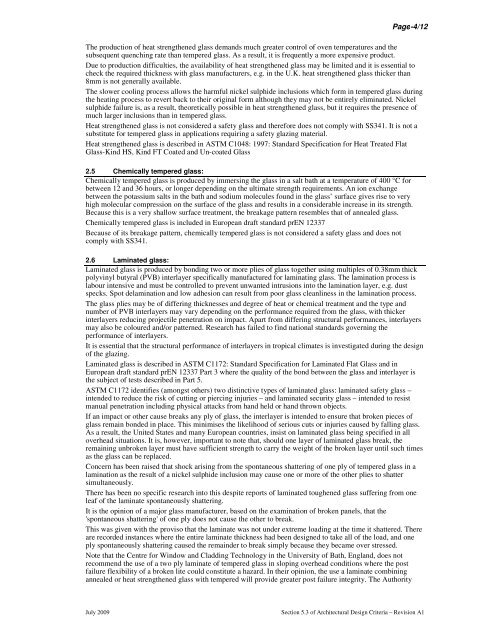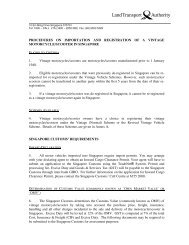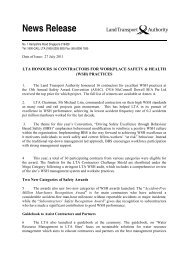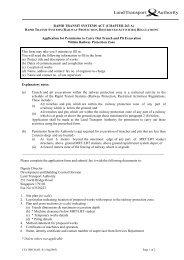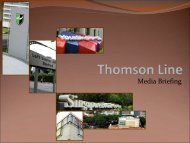ADC Section 5 - Support Design Guidelines - Land Transport Authority
ADC Section 5 - Support Design Guidelines - Land Transport Authority
ADC Section 5 - Support Design Guidelines - Land Transport Authority
- No tags were found...
You also want an ePaper? Increase the reach of your titles
YUMPU automatically turns print PDFs into web optimized ePapers that Google loves.
Page-4/12The production of heat strengthened glass demands much greater control of oven temperatures and thesubsequent quenching rate than tempered glass. As a result, it is frequently a more expensive product.Due to production difficulties, the availability of heat strengthened glass may be limited and it is essential tocheck the required thickness with glass manufacturers, e.g. in the U.K. heat strengthened glass thicker than8mm is not generally available.The slower cooling process allows the harmful nickel sulphide inclusions which form in tempered glass duringthe heating process to revert back to their original form although they may not be entirely eliminated. Nickelsulphide failure is, as a result, theoretically possible in heat strengthened glass, but it requires the presence ofmuch larger inclusions than in tempered glass.Heat strengthened glass is not considered a safety glass and therefore does not comply with SS341. It is not asubstitute for tempered glass in applications requiring a safety glazing material.Heat strengthened glass is described in ASTM C1048: 1997: Standard Specification for Heat Treated FlatGlass-Kind HS, Kind FT Coated and Un-coated Glass2.5 Chemically tempered glass:Chemically tempered glass is produced by immersing the glass in a salt bath at a temperature of 400 °C forbetween 12 and 36 hours, or longer depending on the ultimate strength requirements. An ion exchangebetween the potassium salts in the bath and sodium molecules found in the glass’ surface gives rise to veryhigh molecular compression on the surface of the glass and results in a considerable increase in its strength.Because this is a very shallow surface treatment, the breakage pattern resembles that of annealed glass.Chemically tempered glass is included in European draft standard prEN 12337Because of its breakage pattern, chemically tempered glass is not considered a safety glass and does notcomply with SS341.2.6 Laminated glass:Laminated glass is produced by bonding two or more plies of glass together using multiples of 0.38mm thickpolyvinyl butyral (PVB) interlayer specifically manufactured for laminating glass. The lamination process islabour intensive and must be controlled to prevent unwanted intrusions into the lamination layer, e.g. dustspecks. Spot delamination and low adhesion can result from poor glass cleanliness in the lamination process.The glass plies may be of differing thicknesses and degree of heat or chemical treatment and the type andnumber of PVB interlayers may vary depending on the performance required from the glass, with thickerinterlayers reducing projectile penetration on impact. Apart from differing structural performances, interlayersmay also be coloured and/or patterned. Research has failed to find national standards governing theperformance of interlayers.It is essential that the structural performance of interlayers in tropical climates is investigated during the designof the glazing.Laminated glass is described in ASTM C1172: Standard Specification for Laminated Flat Glass and inEuropean draft standard prEN 12337 Part 3 where the quality of the bond between the glass and interlayer isthe subject of tests described in Part 5.ASTM C1172 identifies (amongst others) two distinctive types of laminated glass: laminated safety glass –intended to reduce the risk of cutting or piercing injuries – and laminated security glass – intended to resistmanual penetration including physical attacks from hand held or hand thrown objects.If an impact or other cause breaks any ply of glass, the interlayer is intended to ensure that broken pieces ofglass remain bonded in place. This minimises the likelihood of serious cuts or injuries caused by falling glass.As a result, the United States and many European countries, insist on laminated glass being specified in alloverhead situations. It is, however, important to note that, should one layer of laminated glass break, theremaining unbroken layer must have sufficient strength to carry the weight of the broken layer until such timesas the glass can be replaced.Concern has been raised that shock arising from the spontaneous shattering of one ply of tempered glass in alamination as the result of a nickel sulphide inclusion may cause one or more of the other plies to shattersimultaneously.There has been no specific research into this despite reports of laminated toughened glass suffering from oneleaf of the laminate spontaneously shattering.It is the opinion of a major glass manufacturer, based on the examination of broken panels, that the'spontaneous shattering' of one ply does not cause the other to break.This was given with the proviso that the laminate was not under extreme loading at the time it shattered. Thereare recorded instances where the entire laminate thickness had been designed to take all of the load, and oneply spontaneously shattering caused the remainder to break simply because they became over stressed.Note that the Centre for Window and Cladding Technology in the University of Bath, England, does notrecommend the use of a two ply laminate of tempered glass in sloping overhead conditions where the postfailure flexibility of a broken lite could constitute a hazard. In their opinion, the use a laminate combiningannealed or heat strengthened glass with tempered will provide greater post failure integrity. The <strong>Authority</strong>July 2009<strong>Section</strong> 5.3 of Architectural <strong>Design</strong> Criteria – Revision A1


